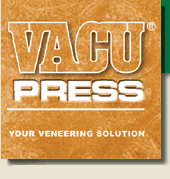Don Stephan

Posts: 825
Joined: 2003-07-18
Location: Cincinnati, Ohio
 User Profile User Profile |
Applying the solid wood edging before veneering means that the edge of the veneer will be exposed to possible chipping. Having solid wood edging will allow you however to slightly round over the edges so there is not a sharp corner to catch and pull.
Water damage is always a potential problem. Probably the majority of manufactured sink and vanity cabinets have melamine coated particle board carcases. I'd expect a careful inspection would show at least a third have an area swollen by prior water exposure. Water doesn't penetrate melamine, so the damage occurs at joints and pipe openings. Can't advise if urea resin glue forms a water barrier under the veneer, but you will still have joints and openings. When I used to build sink bases, I always included a pull out tray. The primary purpose was to allow access to items stored in the sink base, but a secondary benefit was a "leak catcher". Leaks and spills are going to happen, occasionally with disastrous results.
Regarding you concern as to whether hardware will hold up to regular use, I 'm going to assume you are wondering if the screw fasteners will hold in an MDF core. Good hardware has a long track record of performing well. As to holding screws, MDF I would rate as good as particle board at holding screws, and again perhaps half the kitchen and bath cabinets in use have particle board cores. Don't blast screws home with high torque screwdrivers. Can't point you towards a source, but I once bought a box of 5/8" screws for mounting European hinges that had a slightly deeper thread than simple wood screws, and might have been a slightly better choice for MDF and particleboard.
If you have any concerns, build a test cabinet or two, ideally one base and one wall. Better to discover design issues and construction challenges there than in the midst of a full set of cabinets.
A suggestion would be to consider building a separate kick base rather than including in each cabinet. Avoids having to notch cabinet sides. Also, the separate base can be built to the length of a run of cabinets. Once installed, the separate cabinets can simply be set in place, much quicker than having to shim and level each and every base cabinet.
A second would be to consider wall cabinets 15" deep rather than the typical 12". The increased projection from the wall doesn't seem to be a problem when working on the counter, and the increased depth sometimes needed for very large serving dishes.
|






